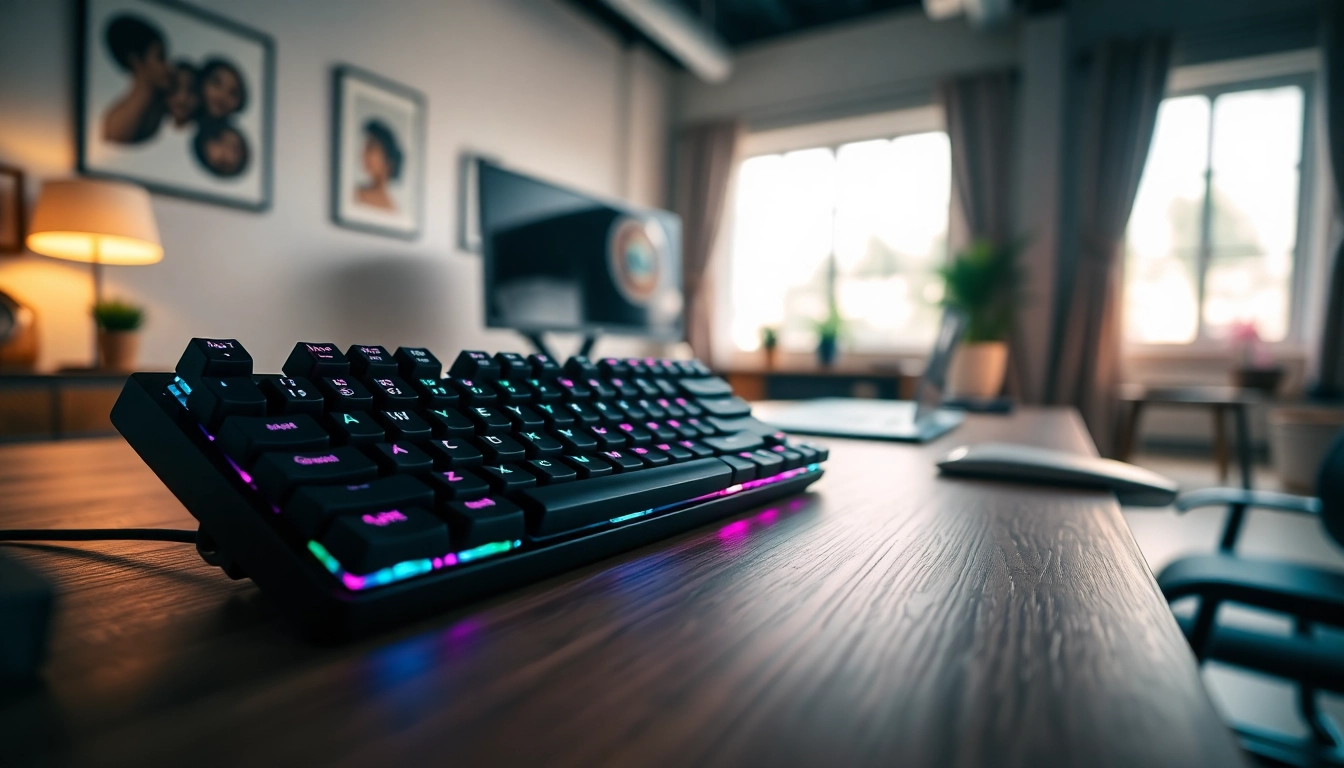Understanding the Importance of a Quality Keyboard
In the realm of computing, the Keyboard is often the unsung hero. From the casual user to the seasoned developer, a quality keyboard can significantly affect productivity, comfort, and overall user experience. With typing being one of the core interactions between the user and their device, understanding its importance becomes paramount.
Why the Keyboard Matters in Everyday Computing
Every day, countless individuals engage in tasks that primarily involve text input. Whether composing an email, coding an application, or chatting with friends, the efficiency of these tasks largely depends on the keyboard at hand. High-quality keyboards are designed not just for functionality but also for ease of use and comfort. Poor keyboard choices can lead to fatigue, reduced typing speed, and increased errors, negatively impacting tasks from simple note-taking to complex data entry.
The Impact of Keyboard Layouts on Typing Efficiency
Keyboards come in various layouts, which can significantly influence typing speed and accuracy. The QWERTY layout is the most widely used, but alternatives like Dvorak and Colemak are gaining traction due to claims of improved efficiency and comfort. Users accustomed to a specific layout may find that switching can disrupt their typing rhythm. Thus, choosing a keyboard layout that complements one’s typing style can lead to substantial time savings and productivity boosts.
Common Features of Keyboards to Consider
When selecting a keyboard, various features can enhance the overall experience. Consideration of factors such as key switch type, backlighting, programmable keys, and build quality can greatly affect usability. Mechanical switches, for instance, offer tactile feedback that many users prefer, while membrane switches are generally quieter and can be more cost-effective. Additionally, features like backlit keys can be invaluable for typists who work in low-light conditions, allowing them to maintain visibility and accuracy.
Choosing the Right Keyboard for Your Needs
With the plethora of options available, selecting the right keyboard tailored to individual needs can seem daunting. Several factors should guide this decision-making process.
Types of Keyboards: Mechanical, Membrane, and More
The market offers various types of keyboards, each catering to different preferences:
- Mechanical Keyboards: These keyboards provide a satisfying tactile response with individual mechanical switches for each key. They often feature customizable options, making them popular among gamers and typists who prioritize performance.
- Membrane Keyboards: These keyboards use a pressure pad system beneath the keys, making them quieter and more affordable. While they may not provide the same tactile feedback, they are ideal for casual users or those requiring less intensive usage.
- Chiclet Keyboards: Characterized by their flat and widely spaced keys, chiclet keyboards are often found in laptops and modern desktops. They can provide a sleek aesthetic while still supporting efficient typing.
- Ergonomic Keyboards: Designed to minimize strain, these keyboards often have a split design or a curved layout. They are especially beneficial for users who may spend extended periods typing and are looking to prevent discomfort.
Assessing Your Typing Style for Optimal Choice
Your typing style—ranging from casual typing to gaming or programming—should play a crucial role in your keyboard selection. Individuals who type for long hours may favor ergonomic or mechanical keyboards for their comfort and support features, while gamers should look for keyboards that offer fast response times and durability under frequent use. Additionally, those who engage in programming may benefit from keyboards with programmable keys, which can streamline workflows by allowing users to create macros for repetitive tasks.
Budget vs. Performance: Finding the Sweet Spot
When selecting a keyboard, balancing budget and performance is vital. While high-end keyboards may offer advanced features and customization options, there are many reliable models available at lower price points that serve basic needs effectively. It’s essential to evaluate how often you’ll use the keyboard and what features will genuinely enhance your experience to ensure that you’re making a financially sound decision without sacrificing quality.
Keyboards for Different Purposes
Different users have varying requirements based on their specific tasks, which further influences their keyboard choice. Let’s delve into a few categories to understand better.
Gaming Keyboards: Features and Advantages
For gamers, the right keyboard can mean the difference between victory and defeat. Gaming keyboards often feature robust builds designed to withstand intense usage, customizable RGB lighting, and programmable macro keys that provide players with quick access to complex combinations. They are typically equipped with mechanical switches that can react faster than their membrane counterparts, contributing to overall gaming performance. Moreover, anti-ghosting technology ensures that multiple key presses are registered simultaneously, which is crucial during fast-paced gameplay.
Ergonomic Keyboards for Enhanced Comfort
As awareness around workplace health increases, ergonomic keyboards have gained significant popularity. Designed to support a natural wrist position, these keyboards help reduce strain and the risk of repetitive strain injuries (RSIs) such as carpal tunnel syndrome. Many ergonomic models come with added features like wrist rests, adjustable angles, and customizable layouts to accommodate various user preferences. Investing in an ergonomic keyboard can lead to improved comfort and productivity over long typing sessions.
Wireless vs. Wired Keyboards: Pros and Cons
The debate over wireless versus wired keyboards has been ongoing for years. Wireless keyboards offer the advantage of portability and a clutter-free workspace, making them ideal for users who prioritize a clean aesthetic. However, they may require battery replacements or recharging, which can be inconvenient for constant users. On the other hand, wired keyboards are generally more reliable in terms of connectivity and can provide faster response times for gaming and professional use. Ultimately, the decision should depend on personal preference, workspace setup, and typical usage scenarios.
Customizing Your Keyboard Experience
Customization can enhance the user experience significantly, allowing individuals to tailor their keyboard according to personal needs and preferences.
Upgrading Keycaps and Switches for Personalization
For enthusiasts, one of the most appealing aspects of mechanical keyboards is the ability to upgrade keycaps and switches. Keycaps come in various materials and designs—ranging from durable ABS plastic to more premium PBT—and can dramatically change both the look and feel of a keyboard. Switch types also differ in terms of tactile feedback; users can experiment with various switches to find what best suits their typing style—be it linear, tactile, or clicky.
Software Tools for Keyboard Customization
Many modern keyboards come equipped with software that allows users to remap keys, create macros, and customize RGB lighting effects. Utilizing these tools can enhance productivity and make tasks more efficient. For instance, gamers can create macros for often-used gameplay commands, while professionals can assign frequently-used shortcuts to easily accessible keys. Understanding and using software customization tools can significantly enhance the overall experience and workflow.
Lighting Effects and Their Impact on Your Workspace
Beyond aesthetics, lighting can enhance typing experiences. Backlighting options can improve visibility during low-light conditions and can be programmed to suit individual preferences. Many keyboards now offer RGB options that allow users to create unique lighting profiles, helping to create an inviting workspace environment. Moreover, adjustable lighting can help reduce eye strain and improve focus, contributing to a better overall productivity experience.
Maintaining and Troubleshooting Your Keyboard
Like any other piece of technology, keyboards require maintenance to ensure longevity and optimal performance. Knowing how to maintain and troubleshoot issues can save users time and frustration.
Proper Cleaning Techniques for Longevity
Regular cleaning can help extend the life of a keyboard greatly. Dust, food particles, and other debris can accumulate between keys, leading to malfunctions and a less hygienic setup. Simple cleaning techniques include using compressed air to remove debris and wiping down surfaces with a damp cloth. For deeper cleaning, keycaps can often be removed (in the case of mechanical keyboards) to clean the surface beneath more thoroughly. Establishing a cleaning routine can keep the keyboard in top shape for years.
Common Issues and How to Resolve Them
Keyboard users may encounter several common problems, including stuck keys, unresponsive buttons, or connectivity issues. Often, these issues can be resolved by checking connections, removing debris, or updating drivers. In the case of physical damage, such as a broken key, replacement keycaps or whole switch assemblies can be purchased and installed. Understanding these common troubleshooting steps can empower users to tackle minor problems on their own.
When to Replace Your Keyboard for Optimal Performance
Over time, even the best keyboards may need to be replaced. Signs of wear such as fading labels, inconsistent key presses, or persistent malfunctions indicate it may be time for a new model. Regular evaluation of keyboard performance is essential; investing in a quality keyboard can enhance productivity and overall satisfaction significantly.




